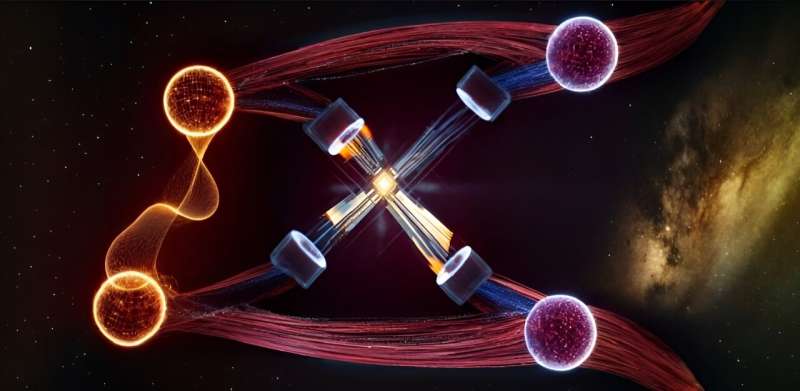This article has been reviewed according to Science X's editorial process and policies. Editors have highlighted the following attributes while ensuring the content's credibility:
fact-checked
trusted source
proofread
Toward testing the quantum behavior of gravity: A photonic quantum simulation

In a development at the intersection of quantum mechanics and general relativity, researchers have made significant strides toward unraveling the mysteries of quantum gravity. This work sheds new light on future experiments that hold promise for resolving one of the most fundamental enigmas in modern physics: the reconciliation of Einstein's theory of gravity with the principles of quantum mechanics.
The longstanding challenge of unifying these two pillars of physics has tantalized scientists for decades, spawning various theoretical frameworks such as string theory and loop quantum gravity. However, without experimental verification, these theories remain speculative.
How to test the quantum nature of gravity? Tangible means to probe the quantum behavior of the gravitational field were proposed within the last decade, based on the concept of "gravity-mediated entanglement."
In a study published in Advanced Photonics Nexus, an international team of researchers achieved a significant goal in preparation for future experiments in the quest to unify quantum mechanics and general relativity. Their work leverages cutting-edge tools and techniques from quantum information theory and quantum optics to demonstrate the principles of gravity-mediated entanglement using particles of light, i.e., photons.
The experiment involves the interaction between photons to mimic the gravitational field's effect on quantum particles. Remarkably, some properties of the photons, despite never directly interacting, become entangled, showcasing a quintessential quantum phenomenon: nonlocality. This entanglement is mediated by another independent photonic property and mirrors the hypothesized behavior of gravity-mediated entanglement, providing crucial insights into the quantum nature of gravity.
Importantly, the study also addresses the challenge of detecting the entanglement generated in these experiments. By elucidating the constraints and noise sources inherent in such experiments, the researchers pave the way for clarifying concepts and tools to be used for future experiments aimed at directly observing gravity-mediated entanglement.
Experimental tests of gravity-mediated entanglement could herald a new era in our understanding of the fundamental nature of the universe. According to author Emanuele Polino, who worked as a postdoc in the Quantum Lab of Sapienza University at the time of the research, supported by the QISS consortium, "The implications of this research are profound. It offers an experimental validation for the principles behind future quantum gravity experiments that will serve as litmus tests for competing theoretical frameworks."
More information: Emanuele Polino et al, Photonic implementation of quantum gravity simulator, Advanced Photonics Nexus (2024). DOI: 10.1117/1.APN.3.3.036011
Provided by SPIE




















